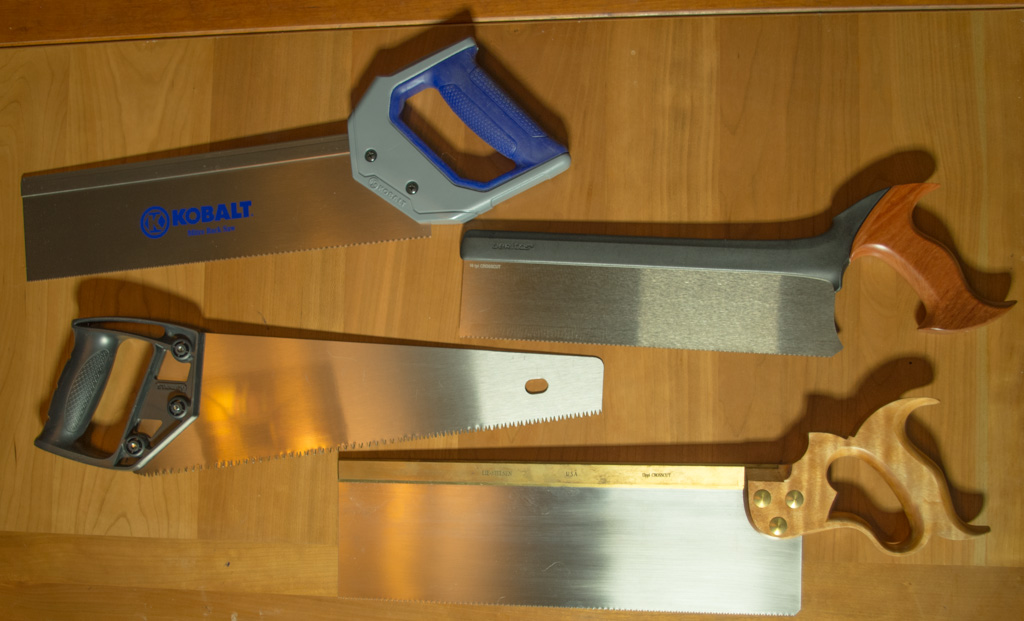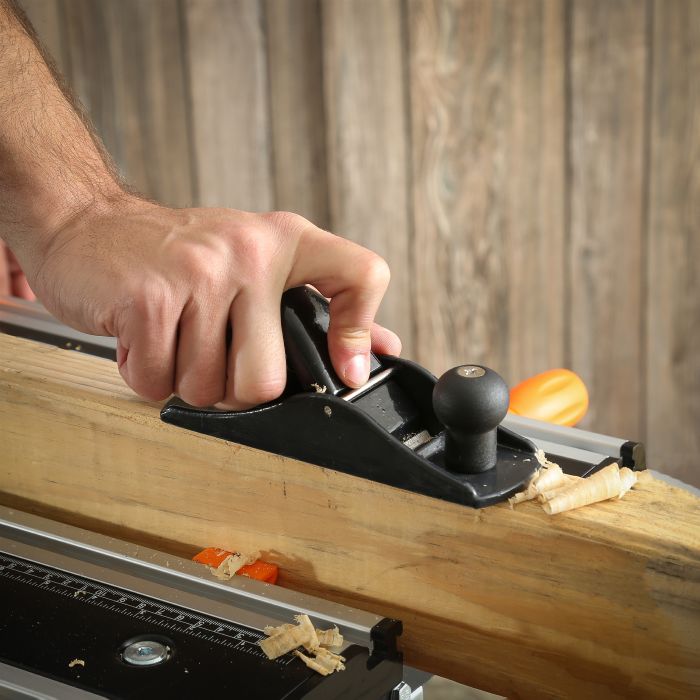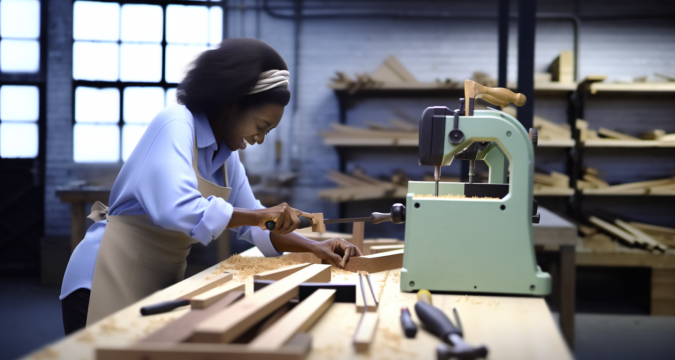
Woodworking with just hand tools can be an incredibly rewarding and satisfying experience. Without the noise, dust, and cost of power tools, you can take a simpler, more methodical approach to the craft. From birdhouses to benches, here are some tips on tackling beginner-friendly projects using basic hand tools.
| Key Takeaways | Description |
|---|---|
| Good first projects | Birdhouses, cutting boards, boxes, coat racks. Build skills in measuring, cutting, joining. |
| Essential hand tools | Saws for crosscutting and ripping, chisels, hand planes, mallets, measuring tools, clamps. Sharpening gear also vital. |
| Key techniques | Safe handling, proper grips, sawing, planing, chiseling, assembly, sanding and finishing. Need patience and practice. |
| Getting good results | Sharp tools, sturdy workbench, quality wood, adequate time. Troubleshoot issues. |
| Buying affordably | Buy incrementally starting with most-used tools. Consider used tools. Compare value, not just cost. |
| Conclusion | Hand tools provide rewarding, tangible woodworking experience. Start simple. Master basics before complex projects. |
Good First Projects to Try with Hand Tools
You don’t need an elaborate workshop or a long list of tools to get started in woodworking. Here are some classic beginner projects that are ideal for making with just hand tools:
- Bird house – Simple rectangular boxes with an entrance hole, these are fun, quick projects that teach basic measuring, cutting, drilling and nailing.
- Cutting board – A butcher block cutting board lets you practice rip and cross cutting on a plank of wood. Once trimmed to size, you can sand and finish it by hand.
- Wooden box – Small lidded boxes make for great hand tool projects. They allow you to try out chiseling, fitting, hinging, and nailing or screwing skills.
- Coat rack – Making a simple hook rack mounted on a backboard is achievable for someone just getting started with handsaws and hammers.
The skills you pick up from projects like these, such as accurate measuring, cutting, assembling and finishing, will serve you well moving forward in your woodworking journey.
Hand Tools Every Beginner Should Own
You can make quite a lot with just a small set of essential woodworking hand tools. Some of the most useful ones to start out with include:
Hand Saws
A crosscut saw trims wood perpendicular to the grain, while a rip saw cuts parallel with it. Having both types allows you flexibility in breaking down lumber. Japanese-style pull saws provide more control and easier cuts than Western-style push saws.

Chisels
Chisels remove waste wood and finely shape openings and details. Pick up a set of basic bench chisels in widths ranging from 1⁄4 inch to 1 inch.
Hand Planes
Hand planes flatten, taper, chamfer and trim lumber surfaces. A standard #4 or #5 model is the most versatile for tasks like edge jointing, surface smoothing and end grain trimming.
Mallet
Soft head mallets protect chisels, gouges and other tools when tapping them to make cuts. Choose a medium sized model about 10 inches long.
Measuring/Marking
A six-foot folding rule, combination square, pencil and marking knife are essential layout tools for transferring dimensions. Quality matters here.
Clamps
F-style bar clamps hold pieces safely aligned while the glue sets on frames, boxes and panels. Four to six clamps allow good versatility.

Pictured: Handsaws for crosscutting and ripping, chisels, block plane, mallet, marking tools, bar clamp
In addition, basic sharpening equipment is vital for keeping tools functioning well. A double-sided oil stone provides fast cutting and finer honing and polishing abrasives. A guide helps hold chisels and plane blades steady at a consistent angle.
Beyond these, glues, pencils, sandpaper and safety gear round out a solid starter toolkit. Building this essential set over time is totally realistic before tackling that first project.
Key Techniques to Master with Hand Tools
More so than power tools, working wood by hand demands good technique and process. Here are some core skills to focus on:
Safe Tool Handling
With no power guards or switches, hand tools require your full attention to operate safely. Follow protocols on direction of cut, body position, clamping, and tool transport and storage.
Proper Grips and Body Positioning
An improper stance or tool grip could lead to subpar cuts or injury. Maintain solid foot placement and balance your body for control. Choke up on tool handles and grip tightly but without tension.
Sawing
Let sharpened saw teeth do the cutting rather than forcing the blade. Use gentle pressure on the forward stroke, ease up on the backstroke and keep your arms moving straight. Cut just inside your lines.
Wood Planing
Adjust the plane for thin shavings. Use even passes with the wood grain tilting the blade slightly to prevent dig in. Plane edges first before smoothing broad surfaces.
Chiseling
Score cut lines with a knife first when paring. Undercut to eliminate long grain tearing. Cut at an angle perpendicular to the wood surface, not flat. Chop out waste in successive layers.
Assembly and Gluing
Dry fit parts first before applying adhesive to ensure proper fit and alignment. Use just enough yellow or white carpenter’s glue or tight bond to make a thin film between joints. Avoid squeeze out.
Sanding and Finishing
Work progressively with grits from coarse to fine for a smooth finish before staining or sealing bare wood. Pay attention to grain direction to prevent obvious scratch marks.
Patience and practice develops mastery of these essential techniques. Be present in the process rather than preoccupied with an end goal.
Getting Good Results from Hand Tools
Beyond skill, several other factors impact your ability to get satisfactory performance from hand tools:
Proper tool sharpening – Both edge tools like chisels and planes as well as saws require incredibly sharp and smooth edges to cut cleanly through wood rather than tearing the fibers apart. Regular honing and sharpening maintenance makes all the difference.
Using a sturdy workbench – To safely use force and leverage hand tools without slipping or tipping, a thick hardwood work top anchored tightly to a heavy base or wall is ideal. The height should suit your physique.
Quality materials – Trying to cut dense exotic woods or poorly dried construction lumber poses added challenges. Seek out higher grades of dimensioned hardwoods from specialty suppliers for easier working and assembly.
Adequate time – Quick cuts or impatient attitudes often yield frustration. Set aside more time than you estimate needing. Slow down and pay attention to each cut and each stroke for improved control over the tools.
Also check for issues like dull edges, inconsistent angles, work piece movement, hidden nails, or difficult grain patterns if you encounter problems rather than automatically blaming poor skills. Problem solving is an inherent part of the hand tool woodworking journey.
Buying Hand Tools Affordably
While hand tools were once ordinary household items, today quality versions carry premium prices that could hinder tooling up. Here are some tips for keeping startup costs reasonable as you accumulate your toolkit:
Buy incrementally – Prioritize the most often used tools like layout tools, saws and chisels, then add others down the road as needed for projects. Spreading out purchases helps minimize impact.
Consider buying used tools – Vintage tools found at flea markets or online may only need some rust removal, sharpening, and a new handle or knob to perform like new again. This offers major savings.
Start with a basic set – Rather than buying individual loose tools, beginner sets, like these woodworking hand tool sets, provide good value to get started. Expand from there over time.
comparison shop – While buying cheap tools seems frugal, poor quality can lead to frustration or danger. Research brands and prices to identify trusted manufacturers of ergonomic, durable, lifetime tools. Consider value, not just cost.
The goal is accumulating versatile, reliable tools for common needs rather than every specialty tool invented. This essential set can carry you through countless projects in the years ahead.
Conclusion
The simplicity, quiet and tangible working experience of hand tools provides a rewarding change from our power tool and digital device dominated world. Don’t be intimidated by jumping straight into an elaborate project. Start instead with the basics – sawing, planing, chiseling. Master these universal skills through creating simple boxes, stools, shelves. Then progress to more complex furniture forms at your own pace.
We highly encourage you to give hand tools a try. Share your motivation and projects with other beginning woodworkers in online communities. Celebrate small milestones and don’t worry about perfect results out of the gate. You may just find a passion for the craft of woodworking as you gain competence working with hand tools.
FAQs:
What are the easiest projects for hand tools?
Simple boxes, bird houses, cutting boards, shop helpers like bench hooks and saw benches are good starter projects for hand tools. The skills transfer to more intricate objects later.
What maintenance do hand tools require?
Sharp edge tools like chisels and hand planes need frequent honing to maintain cutting performance and prevent damage to wood. Keep them protected in holders when not in use. Clean saws regularly and apply paste wax to their blades after use to resist rust.
Is it realistic to make furniture with just hand tools?
With practice and patience, hand tools can produce professional quality furniture from chairs to cabinets to beds. The limitation is more on time investment than quality of results. Many seasoned woodworkers choose hand tools for certain tactile control they provide over machines.
How can I learn woodworking without power tools?
Aside from online tutorials and books from the library, many community colleges and woodworking clubs offer introductory hand tool classes. Making sawdust alongside fellow learners provides tips and accountability for applying the techniques correctly.
What are the main advantages of using hand tools?
Lower noise levels, minimized equipment costs, smaller space requirements and enhanced tactile feedback for more control over cuts give hand tool woodworking an appeal. The slower pace also provides a nice contrast to our technology dependent world.
What should I look for when buying used hand tools?
Check for pitting, cracks, loose handles or other damage. Give edge tools a few test cuts on scrap wood. Solid brands, sharp, clean tools suggest previous owners who also valued performance. Beware of heavily worn or rusty tools signaling neglect.
What sharpening tools do I need?
Start with an oil stone (combination of coarse and fine grits) lubricated with honing oil. Add a guide with various angle slots for setting bevels on chisels and plane irons consistently. Stropping compound on leather final polishes an already sharp edge.
Resources
Here are some helpful sites to continue learning hand tool woodworking:
- 10 Hand Tool Woodworking Projects for Beginners from TheSpruceCrafts.com
- 5 Great Woodworking Projects for Kids from MakeZine.com
Woodworking for Kids from PopularWoodworking.com

